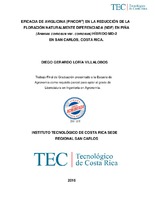Mostrar el registro sencillo del ítem
Eficacia de AVIGLICINA (PINCOR®) en la reducción de la floración naturalmente diferenciada (NDF) en piña (Ananas comosus var. Comosus) HÍBRIDO MD-2 en San Carlos, Costa Rica
| dc.contributor.author | Loría-Villalobos, Diego Gerardo | |
| dc.date.accessioned | 2019-06-03T20:15:16Z | |
| dc.date.available | 2019-06-03T20:15:16Z | |
| dc.date.issued | 2016 | |
| dc.identifier.uri | https://hdl.handle.net/2238/10653 | |
| dc.description | Proyecto de Graduación (Licenciatura en Ingeniería en Agronomía). Instituto Tecnológico de Costa Rica, Escuela de Agronomía, 2016. | es |
| dc.description.abstract | In Costa Rica, pineapple (Ananas comosus var. comosus) is the second most important product with a performance of 7% of total exports. The forcing process, allows a constant and programmed production of fruit throughout the year, which is the key of the sustainability of farms. The Naturally Differentiated Flowering of pineapple (NDF) is the major limiting factor in the orderly production, resulting in unscheduled fruitfulness and it is considered one of the biggest problems; especially, from December to March. NDF increases production costs and reduces the benefits for the producer. This phenomenon is regulated by various environmental factors, principally low temperatures and short days, which stimulate the increase of ethylene biosynthesis. AVG is an agent that inhibits ethylene biosynthesis, several authors’ state that AVG reduces and delays the NDF in pineapple. The PinCor® formulation is considered as an alternative to reduce the incidence of NDF in pineapple plantations; as a result, it arises the need to prove it through field studies. The aim of this study was to evaluate the effectiveness of Aviglycine (PinCor®) in reducing the NDF in hybrid MD-2 pineapple during the year’s biggest susceptibility period. The research was conducted in Agricola Agromonte S.A., located in Boca de Arenal, San Carlos, Alajuela, Costa Rica. In two batches within the farm, there were used three doses of PinCor® (0.25 L/ha, 0.50 L/ha and 1.0 L/ha) applied at high volume (2,000 L/ha) were evaluated at low volume solution (25 L/ha) plus an absolute control. In the process, plants of 213- 225 days old were treated, with average plant weight of 1.7 kg to 1.87 kg. Consecutive weekly applications were made, starting in week 48 of 2015 and concluding in week 08 of 2016. The results show that PinCor® (AVG) in doses of 0.25 L/ha, 0.50 L/ha and 1.0 L/ha, applied in solution volume of 25 L/ha (2,000 ppm, 4,000 ppm and 8,000 ppm a.i) and solution volume of 2,000 L/ha (25 ppm, 50 ppm and 100 ppm) reduced the natural flowering from 43.7% to 6.9% in contrast to untreated plants; during the week 48 of 2015 to week 08 of 2016. The batch factor was shown to be statistically significant (p<0.001) in the expression of the NDF, where the magnitude of the impact can be influenced by specific conditions to each microenvironment. Levels of application volume (25 L/ha and 2,000 L/ha) factor were not significant xiv (p=0.10) in the efficacy of PinCor®. Instead each dose level application PinCor® showed highly significant differences (p <0.001), as the dose (0.25 L/ha, 0.5 L/ha and 1.0 L/ha increases has) the percentage incidence of NDF was lower. The best result was obtained with the dose of 1.0 L/ha applied at 25 L/ha (corresponding to 8,000 ppm), which suppress incidence of NDF (0% NDF). It was found that PinCor® in concentrations of 2,000 ppm to 8,000 ppm a.i, applied in solution 25 L/ha, can generate temporary chlorotic symptoms in response to high concentration of a.i. The incidence of 100% of NDF was expressed during the second week of 2016 to week number eight 2016, with the highest incidence during week three (24.4%), week five (23.5%) and week six (27.1%) 2016. The NDF events are related to daily plantation exposure for over than 50 minutes to conditions of temperatures below 20 °C associated with a differential temperature below 4 °C, and on a higher daily exposure under the same terms, the NDF tends to increase. Based on the percentages of fruits obtained by natural flowering and artificial induction (forcing) no evidence was found that AVG affect the plant sensitivity to exogenous ethylene applied as foliar by ethylene gas. The observed variation in the incidence of NDF in plants treated with Aviglycine (PinCor®) and untreated plants, demonstrates that AVG reduces NDF pineapple, and can suppress the phenomenon with foliar application of 8,000 ppm a.i, applied to low volume of solution. Under the environmental and cultural conditions of cultivation, NDF events occurred with greater magnitude in January and February. NDF expression coincides with conditions of low temperatures below 20 °C. AVG not affect the sensitivity of pineapple plants to exogenous ethylene. | es |
| dc.language.iso | spa | es |
| dc.publisher | Instituto Tecnológico de Costa Rica | es |
| dc.rights | acceso abierto | es |
| dc.subject | Producción agrícola | es |
| dc.subject | Frutas tropicales | es |
| dc.subject | Exportación | es |
| dc.subject | Botánica | es |
| dc.subject | Morfología de la planta | es |
| dc.subject | Research Subject Categories::FORESTRY, AGRICULTURAL SCIENCES and LANDSCAPE PLANNING | es |
| dc.title | Eficacia de AVIGLICINA (PINCOR®) en la reducción de la floración naturalmente diferenciada (NDF) en piña (Ananas comosus var. Comosus) HÍBRIDO MD-2 en San Carlos, Costa Rica | es |
| dc.type | proyecto fin de carrera | es |


